
How to Use XIAO ESP32C3: Examples, Pinouts, and Specs
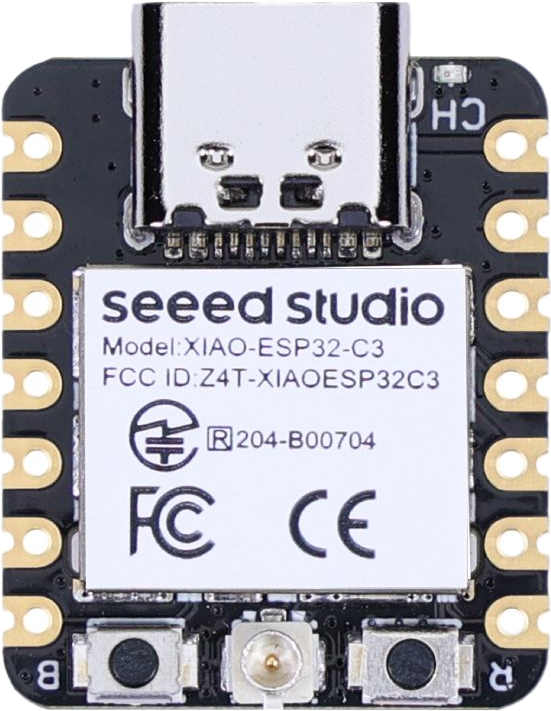
 Design with XIAO ESP32C3 in Cirkit Designer
Design with XIAO ESP32C3 in Cirkit DesignerIntroduction
The XIAO ESP32C3 by Seeed Studio is a compact microcontroller board powered by the ESP32-C3 chip. It features built-in Wi-Fi and Bluetooth Low Energy (BLE) capabilities, making it an excellent choice for Internet of Things (IoT) projects and wireless communication applications. Its small form factor and low power consumption make it ideal for wearable devices, smart home systems, and other embedded applications.
Explore Projects Built with XIAO ESP32C3
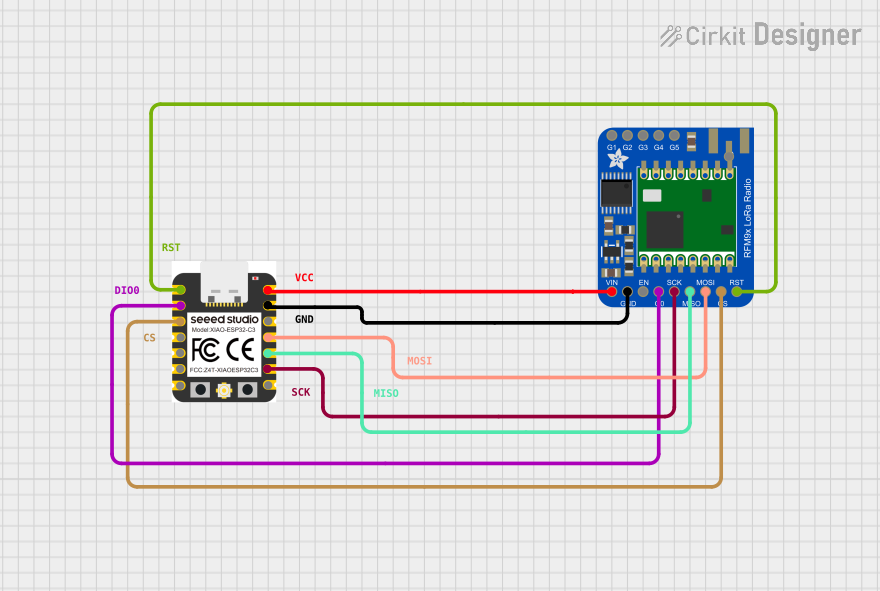
 Open Project in Cirkit Designer
Open Project in Cirkit Designer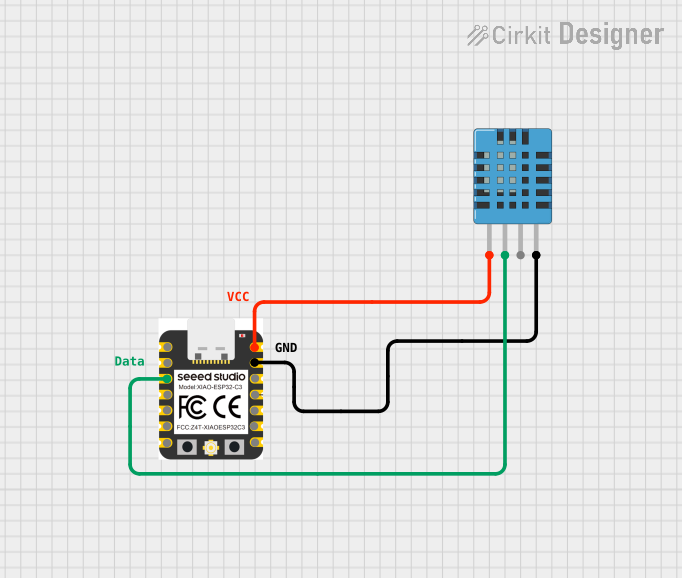
 Open Project in Cirkit Designer
Open Project in Cirkit Designer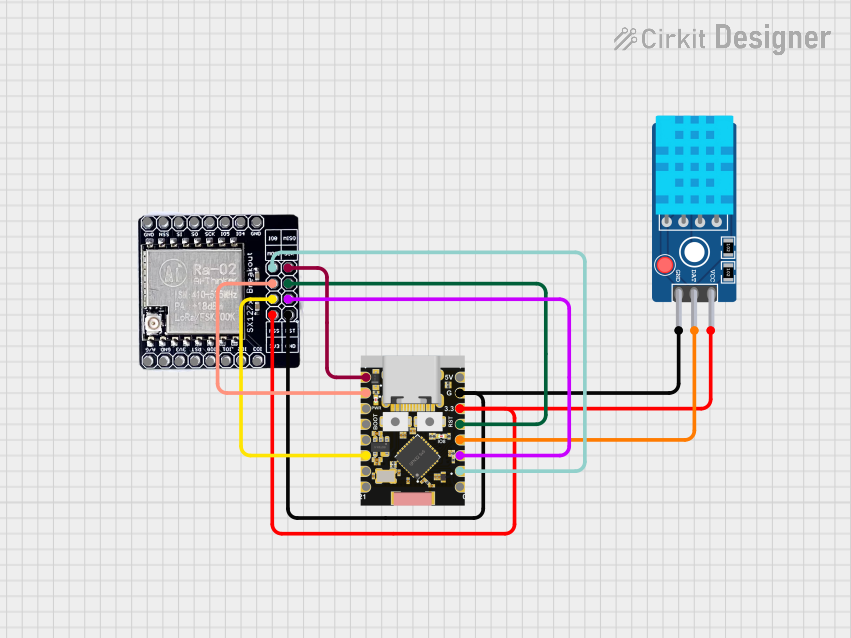
 Open Project in Cirkit Designer
Open Project in Cirkit Designer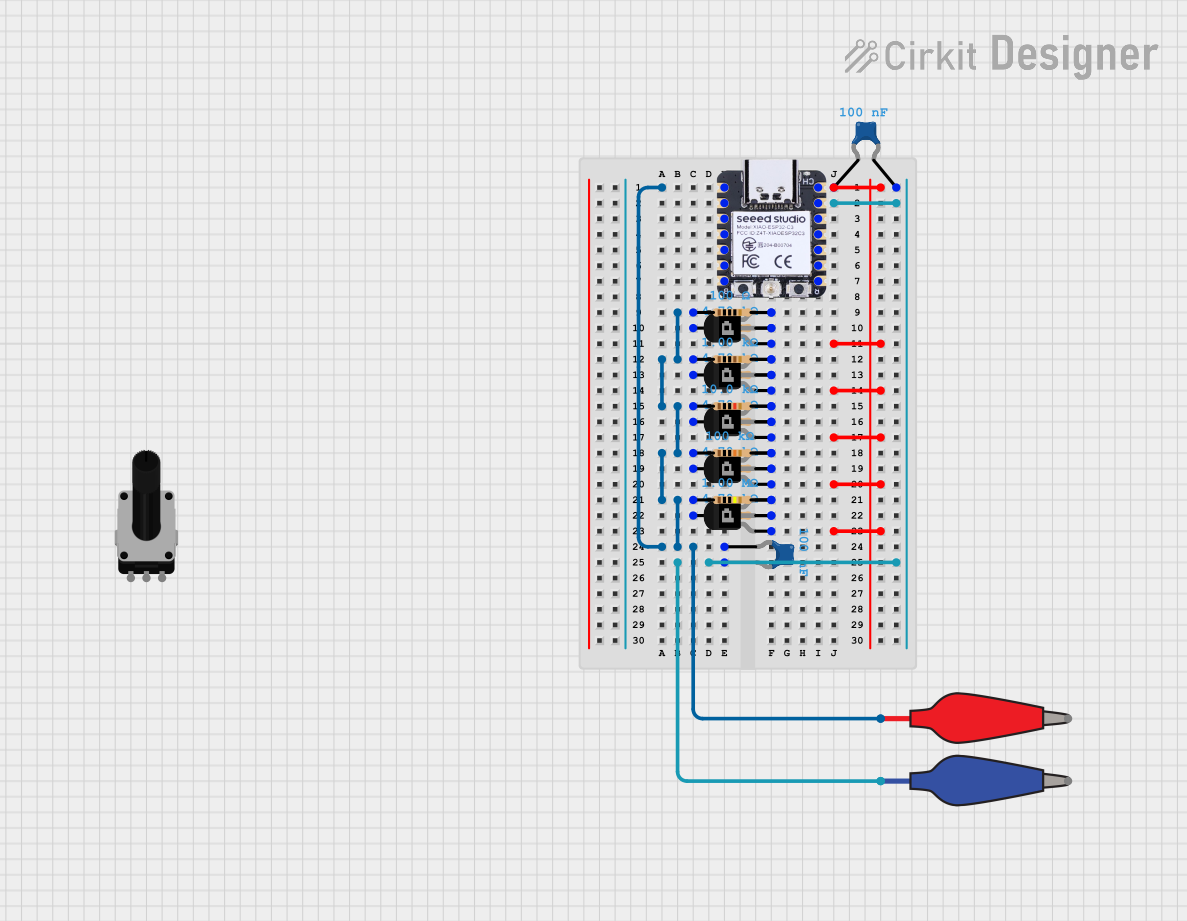
 Open Project in Cirkit Designer
Open Project in Cirkit DesignerExplore Projects Built with XIAO ESP32C3

 Open Project in Cirkit Designer
Open Project in Cirkit Designer
 Open Project in Cirkit Designer
Open Project in Cirkit Designer
 Open Project in Cirkit Designer
Open Project in Cirkit Designer
 Open Project in Cirkit Designer
Open Project in Cirkit DesignerCommon Applications
- IoT devices and smart home automation
- Wearable electronics
- Wireless sensor networks
- Prototyping for Bluetooth and Wi-Fi-enabled projects
- Low-power applications requiring compact designs
Technical Specifications
The following table outlines the key technical details of the XIAO ESP32C3:
| Parameter | Specification |
|---|---|
| Microcontroller | ESP32-C3 (RISC-V single-core processor) |
| Clock Speed | Up to 160 MHz |
| Flash Memory | 4 MB |
| SRAM | 400 KB |
| Wireless Connectivity | Wi-Fi 802.11 b/g/n, Bluetooth 5.0 (LE) |
| Operating Voltage | 3.3V |
| Input Voltage Range | 5V (via USB-C) |
| GPIO Pins | 11 (including ADC, I2C, SPI, UART, PWM) |
| Dimensions | 21 x 17.5 mm |
Pin Configuration and Descriptions
The XIAO ESP32C3 has a total of 11 GPIO pins, which are multifunctional and can be configured for various purposes. Below is the pinout description:
| Pin | Function | Description |
|---|---|---|
| 0 | GPIO, ADC, UART RX | General-purpose I/O, analog input, UART receive |
| 1 | GPIO, ADC, UART TX | General-purpose I/O, analog input, UART transmit |
| 2 | GPIO, ADC, PWM | General-purpose I/O, analog input, PWM output |
| 3 | GPIO, ADC, I2C SDA | General-purpose I/O, analog input, I2C data line |
| 4 | GPIO, ADC, I2C SCL | General-purpose I/O, analog input, I2C clock line |
| 5 | GPIO, SPI SCK | General-purpose I/O, SPI clock |
| 6 | GPIO, SPI MISO | General-purpose I/O, SPI data input |
| 7 | GPIO, SPI MOSI | General-purpose I/O, SPI data output |
| 8 | GPIO, PWM | General-purpose I/O, PWM output |
| 9 | GPIO, PWM | General-purpose I/O, PWM output |
| 10 | GPIO, ADC | General-purpose I/O, analog input |
Usage Instructions
How to Use the XIAO ESP32C3 in a Circuit
Powering the Board:
- Use a USB-C cable to supply 5V to the board. The onboard voltage regulator will step it down to 3.3V for the microcontroller.
- Alternatively, you can power the board via the 3.3V pin if an external regulated power source is available.
Connecting Peripherals:
- Use the GPIO pins to connect sensors, actuators, or other peripherals. Ensure the voltage levels of connected devices are compatible with the 3.3V logic of the XIAO ESP32C3.
- For communication protocols like I2C, SPI, or UART, connect the appropriate pins as per the pinout table.
Programming the Board:
- Install the Arduino IDE and add the ESP32 board support package.
(Instructions for adding the ESP32 board package can be found on the official Arduino website.) - Select "Seeed XIAO ESP32C3" as the board in the Arduino IDE.
- Connect the board to your computer via USB-C and upload your code.
- Install the Arduino IDE and add the ESP32 board support package.
Example Code: Blink an LED
The following example demonstrates how to blink an LED connected to GPIO pin 2:
// Define the GPIO pin where the LED is connected
const int ledPin = 2;
void setup() {
// Set the LED pin as an output
pinMode(ledPin, OUTPUT);
}
void loop() {
// Turn the LED on
digitalWrite(ledPin, HIGH);
delay(1000); // Wait for 1 second
// Turn the LED off
digitalWrite(ledPin, LOW);
delay(1000); // Wait for 1 second
}
Important Considerations
- Voltage Levels: Ensure all connected peripherals operate at 3.3V logic levels to avoid damaging the board.
- Wi-Fi and Bluetooth Usage: When using wireless features, ensure the antenna area is not obstructed for optimal signal strength.
- Power Consumption: For battery-powered applications, use deep sleep modes to minimize power consumption.
Troubleshooting and FAQs
Common Issues and Solutions
The board is not detected by the computer:
- Ensure the USB-C cable is a data cable (not a charge-only cable).
- Check if the correct drivers for the ESP32-C3 are installed on your computer.
Code upload fails:
- Verify that the correct board and port are selected in the Arduino IDE.
- Press the reset button on the board before uploading the code.
Wi-Fi or Bluetooth is not working:
- Ensure the antenna area is clear of obstructions.
- Double-check the SSID and password for Wi-Fi connections in your code.
Peripherals are not responding:
- Confirm that the peripherals are connected to the correct GPIO pins.
- Check the voltage levels and ensure compatibility with the 3.3V logic of the board.
FAQs
Q: Can I power the XIAO ESP32C3 with a battery?
A: Yes, you can use a 3.7V LiPo battery connected to the 3.3V pin with a proper voltage regulator.
Q: Does the board support OTA (Over-the-Air) updates?
A: Yes, the ESP32-C3 chip supports OTA updates, which can be implemented in your code.
Q: What is the maximum current output of the GPIO pins?
A: Each GPIO pin can source or sink up to 40 mA, but it is recommended to stay below 20 mA for safe operation.
Q: Can I use the XIAO ESP32C3 with MicroPython?
A: Yes, the board supports MicroPython. You can flash the MicroPython firmware to the board and use it for development.
This concludes the documentation for the XIAO ESP32C3. For further assistance, refer to the official Seeed Studio documentation or community forums.